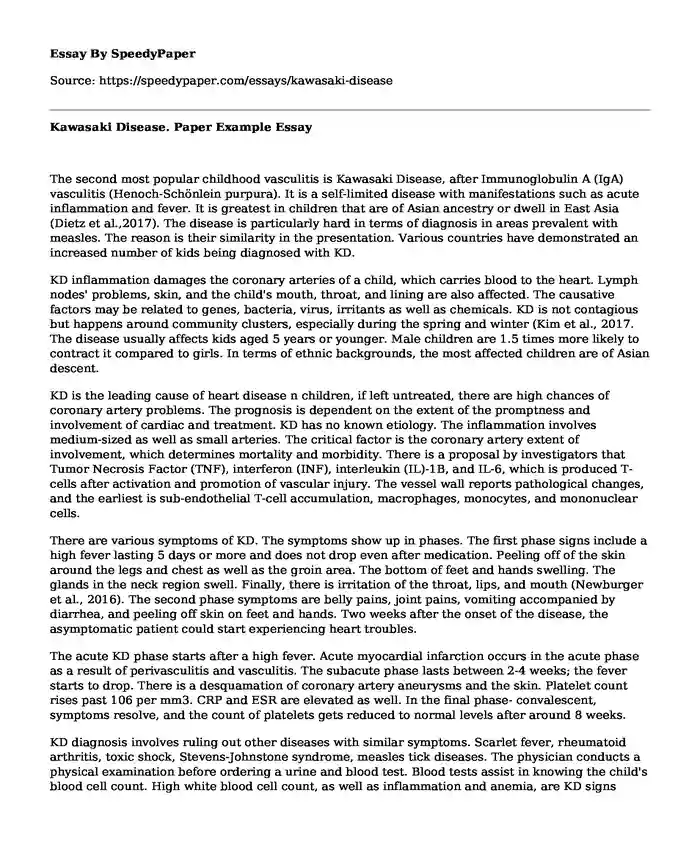
| Type of paper: | Essay |
| Categories: | Medicine Asia Disorder Essays by pagecount |
| Pages: | 3 |
| Wordcount: | 745 words |
The second most popular childhood vasculitis is Kawasaki Disease, after Immunoglobulin A (IgA) vasculitis (Henoch-Schönlein purpura). It is a self-limited disease with manifestations such as acute inflammation and fever. It is greatest in children that are of Asian ancestry or dwell in East Asia (Dietz et al.,2017). The disease is particularly hard in terms of diagnosis in areas prevalent with measles. The reason is their similarity in the presentation. Various countries have demonstrated an increased number of kids being diagnosed with KD.
KD inflammation damages the coronary arteries of a child, which carries blood to the heart. Lymph nodes' problems, skin, and the child's mouth, throat, and lining are also affected. The causative factors may be related to genes, bacteria, virus, irritants as well as chemicals. KD is not contagious but happens around community clusters, especially during the spring and winter (Kim et al., 2017. The disease usually affects kids aged 5 years or younger. Male children are 1.5 times more likely to contract it compared to girls. In terms of ethnic backgrounds, the most affected children are of Asian descent.
KD is the leading cause of heart disease n children, if left untreated, there are high chances of coronary artery problems. The prognosis is dependent on the extent of the promptness and involvement of cardiac and treatment. KD has no known etiology. The inflammation involves medium-sized as well as small arteries. The critical factor is the coronary artery extent of involvement, which determines mortality and morbidity. There is a proposal by investigators that Tumor Necrosis Factor (TNF), interferon (INF), interleukin (IL)-1B, and IL-6, which is produced T-cells after activation and promotion of vascular injury. The vessel wall reports pathological changes, and the earliest is sub-endothelial T-cell accumulation, macrophages, monocytes, and mononuclear cells.
There are various symptoms of KD. The symptoms show up in phases. The first phase signs include a high fever lasting 5 days or more and does not drop even after medication. Peeling off of the skin around the legs and chest as well as the groin area. The bottom of feet and hands swelling. The glands in the neck region swell. Finally, there is irritation of the throat, lips, and mouth (Newburger et al., 2016). The second phase symptoms are belly pains, joint pains, vomiting accompanied by diarrhea, and peeling off skin on feet and hands. Two weeks after the onset of the disease, the asymptomatic patient could start experiencing heart troubles.
The acute KD phase starts after a high fever. Acute myocardial infarction occurs in the acute phase as a result of perivasculitis and vasculitis. The subacute phase lasts between 2-4 weeks; the fever starts to drop. There is a desquamation of coronary artery aneurysms and the skin. Platelet count rises past 106 per mm3. CRP and ESR are elevated as well. In the final phase- convalescent, symptoms resolve, and the count of platelets gets reduced to normal levels after around 8 weeks.
KD diagnosis involves ruling out other diseases with similar symptoms. Scarlet fever, rheumatoid arthritis, toxic shock, Stevens-Johnstone syndrome, measles tick diseases. The physician conducts a physical examination before ordering a urine and blood test. Blood tests assist in knowing the child's blood cell count. High white blood cell count, as well as inflammation and anemia, are KD signs (Phuong et al., 2017). Checking BNP released after the heart is under stress. The child's heartbeat is measured using an electrocardiogram.
Early treatment reduces the effects of KD in children, mostly when they still have a fever. It helps prevent damage to the heart. When gamma-globulin is infused intravenously, there is a lower risk of problems with the coronary artery. The other option is the use of aspirin to reduce or treat inflammation.
References
Dietz, S. M., Van Stijn, D., Burgner, D., Levin, M., Kuipers, I. M., Hutten, B. A., & Kuijpers, T. W. (2017). Dissecting Kawasaki disease: a state-of-the-art review. European journal of pediatrics, 176(8), 995-1009.
Kim, G. B., Park, S., Eun, L. Y., Han, J. W., Lee, S. Y., Yoon, K. L., ... & Lee, K. Y. (2017). Epidemiology and clinical features of Kawasaki disease in South Korea, 2012–2014. The Pediatric infectious disease journal, 36(5), 482-485.
Newburger, J. W., Takahashi, M., & Burns, J. C. (2016). Kawasaki disease. Journal of the American College of Cardiology, 67(14), 1738-1749.
Phuong, L. K., Bonetto, C., Buttery, J., Pernus, Y. B., Chandler, R., Felicetti, P., ... & Shulman, S. T. (2017). Kawasaki disease and immunization: A systematic review. Vaccine, 35(14), 1770-1779.
Cite this page
Kawasaki Disease. Paper Example. (2023, Aug 11). Retrieved from https://speedypaper.net/essays/kawasaki-disease
Request Removal
If you are the original author of this essay and no longer wish to have it published on the SpeedyPaper website, please click below to request its removal:
- Free Essay on Recommendations for MTBSA
- Media Watch Assignment, Free Paper Sample
- Middle East Essay Sample
- Marketing Management - Vlog Script, Free Paper Sample for You
- Business Essay Example: Allergan's Merger/Acquisition of Biogen Inc.
- Interview with an Elderly Person - Paper Example
- Research Paper on Roles of Educators in Making the American Dream Attainable
Popular categories




